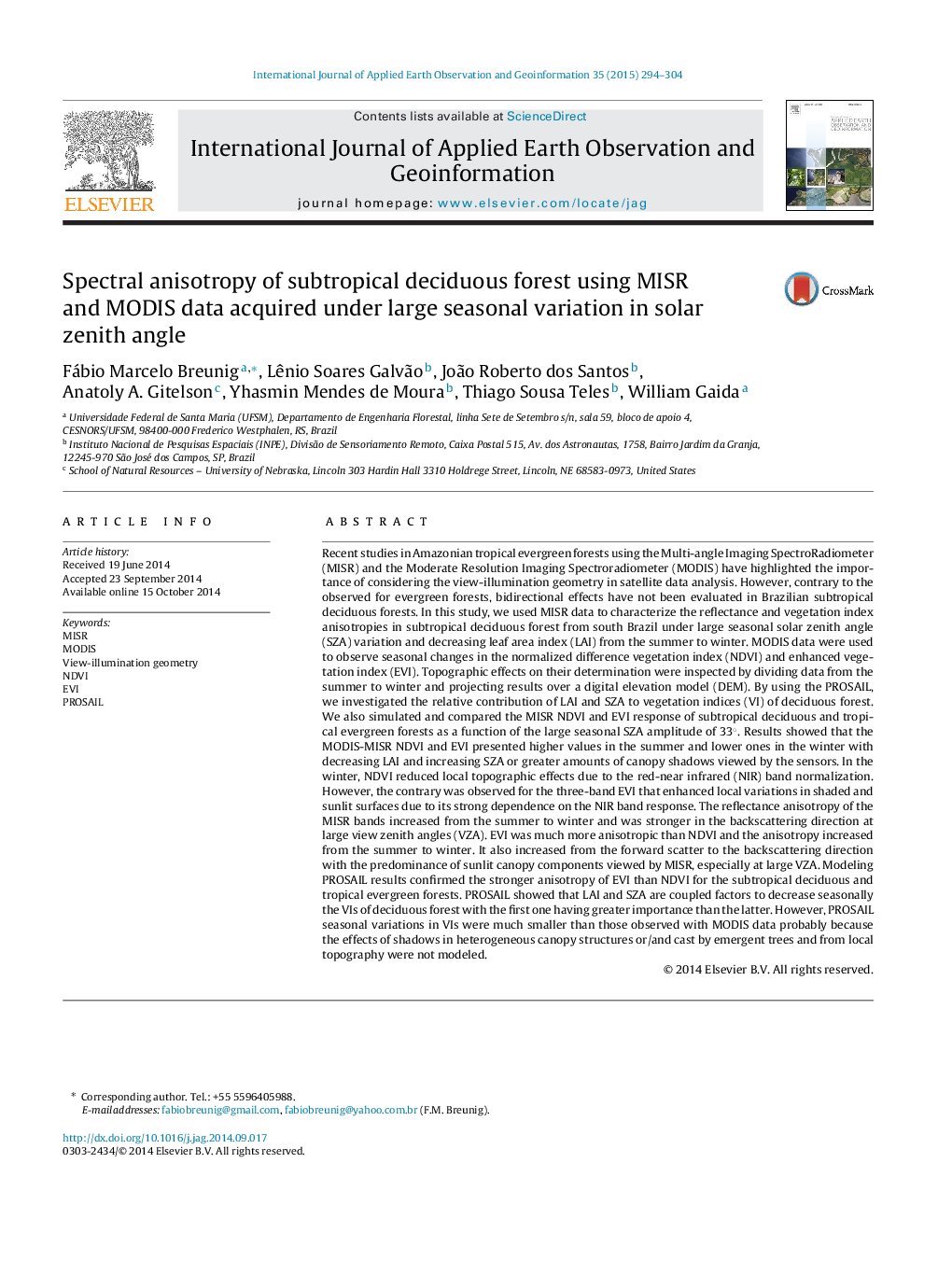| کد مقاله | کد نشریه | سال انتشار | مقاله انگلیسی | نسخه تمام متن |
|---|---|---|---|---|
| 4464723 | 1621823 | 2015 | 11 صفحه PDF | دانلود رایگان |

• Brazilian subtropical forests are sensed by MISR/MODIS at large seasonal SZA change.
• EVI is more anisotropic than NDVI with decreasing LAI and large SZA in the winter.
• MISR anisotropy increased from the summer to winter at backscattering and large VZA.
• NDVI reduced topographic effects under large SZA due to red-NIR band normalization.
• From PROSAIL, LAI was more important than SZA to decrease VIs of deciduous forests.
Recent studies in Amazonian tropical evergreen forests using the Multi-angle Imaging SpectroRadiometer (MISR) and the Moderate Resolution Imaging Spectroradiometer (MODIS) have highlighted the importance of considering the view-illumination geometry in satellite data analysis. However, contrary to the observed for evergreen forests, bidirectional effects have not been evaluated in Brazilian subtropical deciduous forests. In this study, we used MISR data to characterize the reflectance and vegetation index anisotropies in subtropical deciduous forest from south Brazil under large seasonal solar zenith angle (SZA) variation and decreasing leaf area index (LAI) from the summer to winter. MODIS data were used to observe seasonal changes in the normalized difference vegetation index (NDVI) and enhanced vegetation index (EVI). Topographic effects on their determination were inspected by dividing data from the summer to winter and projecting results over a digital elevation model (DEM). By using the PROSAIL, we investigated the relative contribution of LAI and SZA to vegetation indices (VI) of deciduous forest. We also simulated and compared the MISR NDVI and EVI response of subtropical deciduous and tropical evergreen forests as a function of the large seasonal SZA amplitude of 33°. Results showed that the MODIS-MISR NDVI and EVI presented higher values in the summer and lower ones in the winter with decreasing LAI and increasing SZA or greater amounts of canopy shadows viewed by the sensors. In the winter, NDVI reduced local topographic effects due to the red-near infrared (NIR) band normalization. However, the contrary was observed for the three-band EVI that enhanced local variations in shaded and sunlit surfaces due to its strong dependence on the NIR band response. The reflectance anisotropy of the MISR bands increased from the summer to winter and was stronger in the backscattering direction at large view zenith angles (VZA). EVI was much more anisotropic than NDVI and the anisotropy increased from the summer to winter. It also increased from the forward scatter to the backscattering direction with the predominance of sunlit canopy components viewed by MISR, especially at large VZA. Modeling PROSAIL results confirmed the stronger anisotropy of EVI than NDVI for the subtropical deciduous and tropical evergreen forests. PROSAIL showed that LAI and SZA are coupled factors to decrease seasonally the VIs of deciduous forest with the first one having greater importance than the latter. However, PROSAIL seasonal variations in VIs were much smaller than those observed with MODIS data probably because the effects of shadows in heterogeneous canopy structures or/and cast by emergent trees and from local topography were not modeled.
Journal: International Journal of Applied Earth Observation and Geoinformation - Volume 35, Part B, March 2015, Pages 294–304